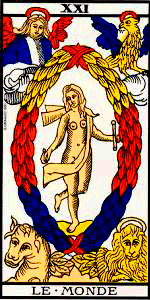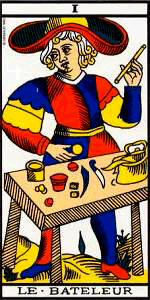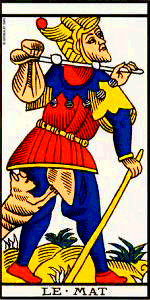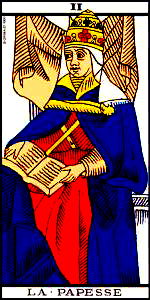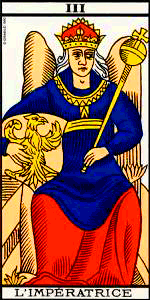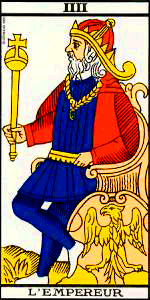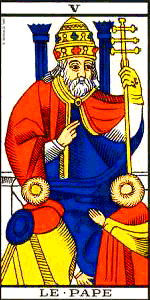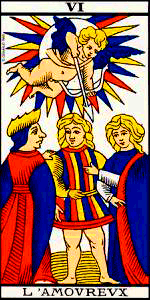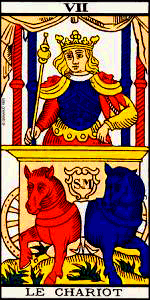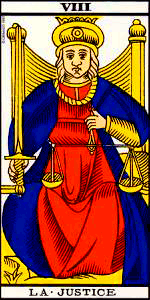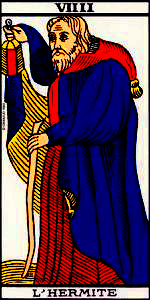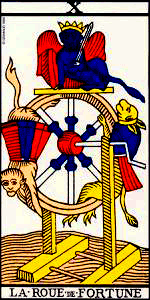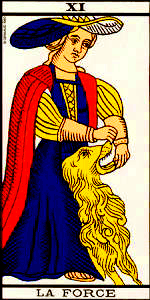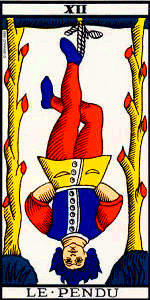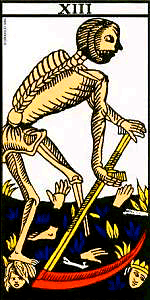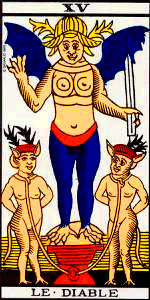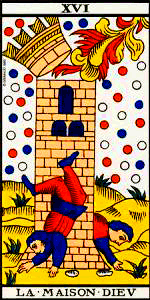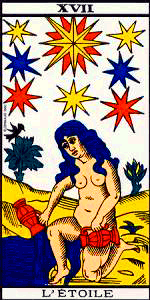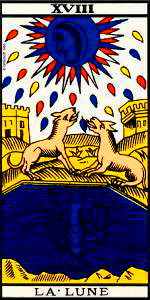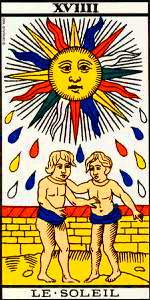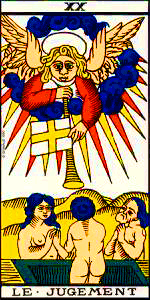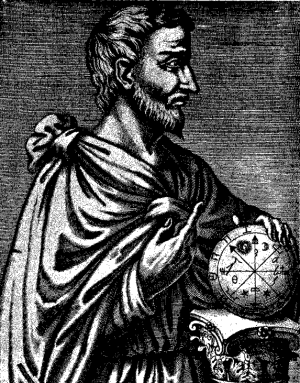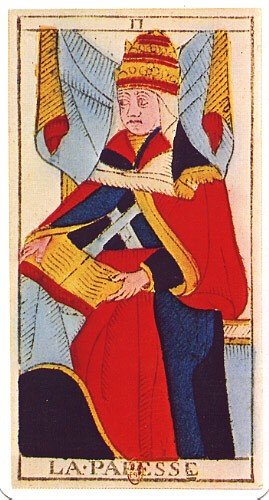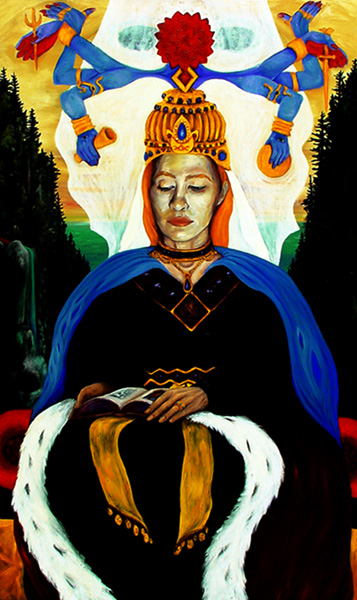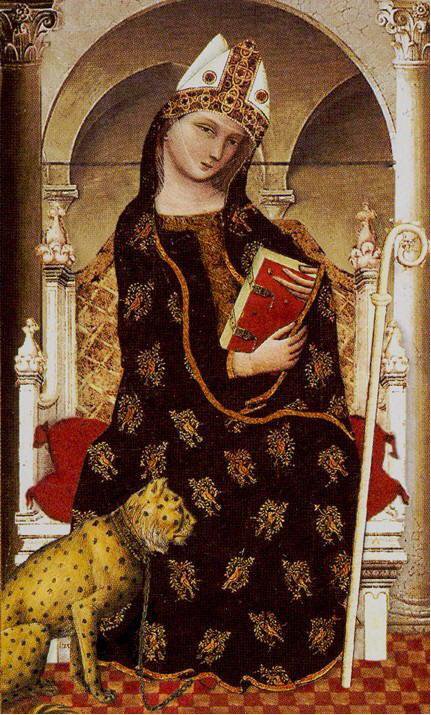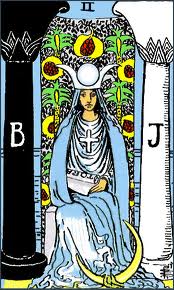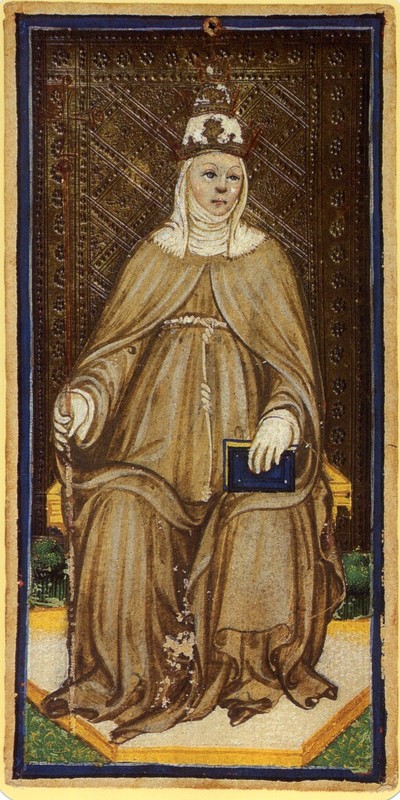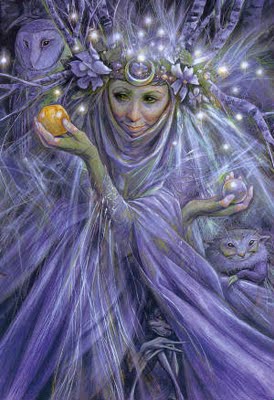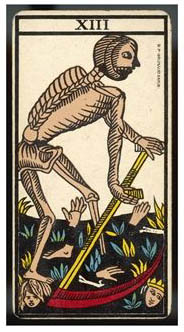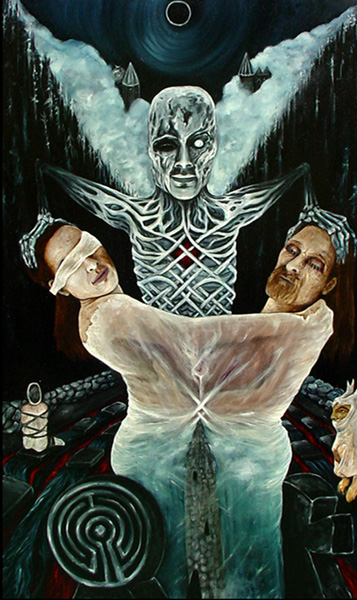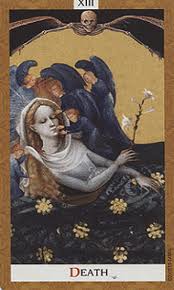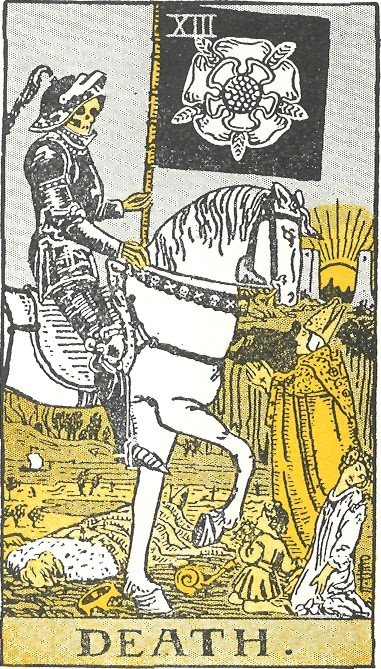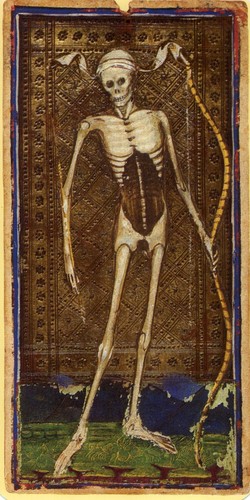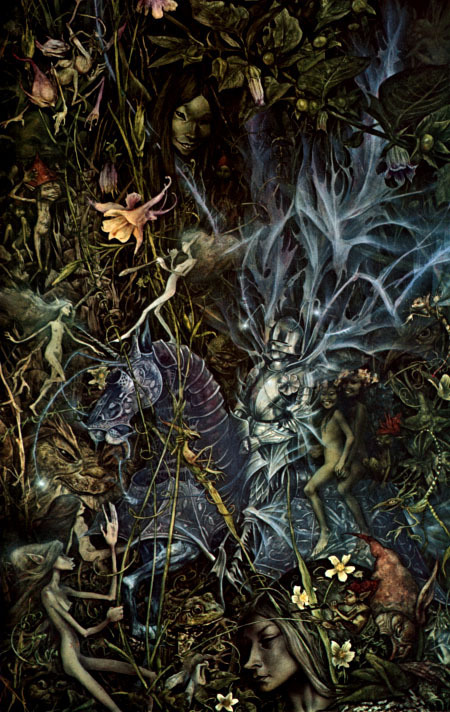|
||||||||||||||||||||||
|
||||||||||||||||||||||
Tarot of Marseilles The 22 Major Arcana of the Tarot of Marseilles deck. |
||||||||||||||||||||||
|
||||||||||||||||||||||
|
Tarot de Marseille Is the Tarot de Marseilles the first "real" Tarot deck? Some research concludes that - based on the lack of earlier documentary evidence - the Tarot deck was probably invented in northern Italy in the fifteenth century. Other scholars who disagree with that theory point to a medieval origin of the game. For the moment, it is ascertained that tarot cards were introduced into southern France from northern Italy when the French conquered Milan and the Piedmont in 1499. The antecedents of the Tarot de Marseille would then have been introduced into southern France at around that time. The game of tarot died out in Italy but survived in France and Switzerland. When the game was reintroduced into northern Italy, the Marseille designs of the cards were also reintroduced to that region. The name Tarot de Marseille is not of particularly ancient vintage; it was coined at least as early as 1889 by the French occultist Papus (Gérard Encausse) in Chapter XI of his book le Tarot des bohémiens (Tarot of the Bohemians), and was popularized in the 1930s by the French cartomancer Paul Marteau, who used this collective name to refer to a variety of closely related designs that were being made in the city of Marseille in the south of France, a city that was a centre of playing card manufacture, and were (in earlier, contemporaneous, and later times) also made in other cities in France. The Tarot de Marseille is one of the standards from which many tarot decks of the nineteenth century and later are derived. Like other Tarot decks, the Tarot de Marseille contains fifty-six cards in the four standard suits. In French language versions of the Tarot de Marseille, those suits are identified by their French names of Bâtons (Rods, Staves, Sceptres, or Wands), Épées (Swords), Coupes (Cups), and Deniers (Coins). These count from Ace to 10. As well, there are four court cards in each suit: a Valet (Knave or Page), Chevalier or Cavalier (Horse-rider or Knight), Reine (Queen) and Roi (King). Occultists (and many tarotists nowadays, whether English- or French-speaking) call this series the "minor arcana" (or "Arcanes mineures", in French). The court cards are sometimes called "Les Honneurs" or "Les Lames Mineures de Figures" in French, and "Royal Arcana" in English. p> There are also the standard twenty-two trump cards. At times, the Fool, which is unnumbered in the Tarot de Marseille, is viewed as separate and additional to the other twenty-one numbered trumps. Occultists (and many tarotists nowadays) call these twenty-two cards the "major arcana" or "Atouts" (or "Arcanes majeures" in French).
|
||||||||||||||||||||||
|
|
||||||||||||||||||||||
|
The Papess ie: Female Pope, "High Priestess" of the Tarot, and the subject of much controversy: |
||||||||||||||||||||||
|
The Papess card has sparked controversy because of its portrayal of a female pope. There is no record evidence of a female pope but this card may be based around the mythical Pope Joan, who is sometimes viewed as the Antichrist. Many variants have been found to escape such controversy including: Juno, The Spanish Captain and The High Priestess. Notice how "Papess" has been replaced by "High Priestess" beginning with the Rider-Waite Tarot in 1908. The Pope as such has been replaced as "The Hierophant". Most successive Tarot decks have replaced Pope and Papess with a more identifiable archetypal symbol for the modern mystic. The imagery has also been taken to a new level, evoking a different level of depth and understanding, The Thoth Tarot for instance goes completely on the left hand path in reinterpreting this archetype. Tarot of the Pomegranate however builds on the original Marseilles Papess imagery ( a powerful symbol in itself) while adding to it a new revelation of symbology in the back ground. |
||||||||||||||||||||||
|
Death, La Mort or the Unnamed card |
||||||||||||||||||||||
|
||||||||||||||||||||||
|
The XIII card is generally left unnamed in the various old and modern versions of the Tarot de Marseille, but it is worth noting that in the Noblet Tarot de Marseille (circa 1650), the card was named LAMORT (Death). In at least some printings of the French/English bilingual version of the Grimaud Tarot de Marseille, the XIII card is named "La Mort" in French and named "Death" in English. In many modern tarot decks (e.g., Rider-Waite-Smith), the XIII card is named Death. In at least one 19th century Italian tarot deck (e.g., the one photoreproduced by Italian publisher Lo Scarabeo as the "Ancient Italian Tarots" deck), the card is named "IL TREDICI" (Thirteen). The use of obviously Christian traditional images (such as the Pope, the Devil, the Grim Reaper and the Last Judgement) and indeed controversial Christian images such as La Papesse -- often thought to represent the legendary Pope Joan -- have spawned controversies from the Renaissance to the present. One variant on the Tarot de Marseille, now called the Swiss Tarot or the Tarot of Besançon, removes the controversial Papess and Pope and, in their stead, puts Juno with her peacock, and Jupiter with his eagle. More recent decks, following a suggestion by Court de Gébelin, often rename the Papess as the "High Priestess", and the Pope as the "Hierophant". During the French Revolution, the Emperor and Empress cards became the subject of similar controversies and were displaced by Grandfather and Grandmother. The Valet de Bâtons (i.e., Page of Batons) is another card worth noting in this regard. In the Tarot de Marseille, the title of that card generally appears on the side of the card, while in some old versions of the Tarot de Marseille that card, along with either some or all others, is left unnamed. As to the east of the French centre is the Besançon/Swiss Junon-Jupiter (II-V) variant, so to the north are variants such as the Flemish decks that replace the Papesse and the Pope with, respectively, the 'Spanish Captain' ("Le'Spagnol Capitano Eracasse") and Bacchus ("Bacus"). In the Tarot de Marseille the fifth card is obviously a Pope. |
||||||||||||||||||||||
| Later History of the Tarot | ||||||||||||||||||||||
|
Each card, whether in the major arcana or minor arcana, was originally printed from a woodcut; the cards were later coloured either by hand or by the use of stencils. One well-known artisan producing tarot cards in the Tarot de Marseille style was Nicolas Conver, who produced one early attested deck in 1760. Other early attested decks in the Tarot de Marseille family of decks include Noblet's (circa 1650) and Dodal's (circa 1701). The chief use of the deck originally was to play the game of tarot, also known as tarock [German] or tarocco [Italian]; the use of tarot in divination is first attested in the eighteenth century in the journals of Giacomo Casanova. It was the Conver deck, or a deck very similar to it, that came to the attention of Antoine Court de Gébelin in the late eighteenth century. Court de Gébelin's writings, which contained much by way of speculation as to the supposed Egyptian origin of the cards and their symbols, called the attention of occultists to tarot decks. As such, Conver's deck became the model for most subsequent esoteric decks, starting with the deck designed by Etteilla forward. Cartomancy with the Tarot was definitely being practised throughout France by the end of the eighteenth century; Alexis-Vincent-Charles Berbiguier reported an encounter with two "sibyls" who divined with Tarot cards in the last decade of the century at Avignon.
|
||||||||||||||||||||||
|
The place and influence of the Tarot de Marseille in French and English Tarot design and usage: In the English-speaking world, where there is little or no tradition of using tarots as playing cards, tarot decks only became known through the efforts of occultists influenced by French tarotists such as Etteilla, and later, Eliphas Lévi. These occultists later produced esoteric decks that reflected their own ideas, and these decks were widely circulated in the anglophone world. Various esoteric decks such as the Rider-Waite-Colman Smith deck (conceived by A. E. Waite and rendered by Pamela Colman Smith), and the Thoth Tarot deck (conceived by Aleister Crowley and rendered by Lady Frieda Harris) -- and tarot decks inspired by those two decks -- are most typically used. Waite, Colman Smith, Crowley and Harris were all former members of the influential, Victorian-era Hermetic Order of the Golden Dawn at different respective points in time; and the Golden Dawn, in turn, was influenced by Lévi and other French occult revivalists. Although there were various other respective influences (e.g., Etteilla's pip card meanings in the case of Waite/Colman Smith), Waite/Colman Smith's and Crowley/Harris' decks were greatly inspired by the Golden Dawn's member-use tarot deck and the Golden Dawn's tarot curriculum. The Hermetic Order of the Golden Dawn was essentially the first in the Anglophone world to venture into esoteric tarot. Francophone occultists such as Court de Gebelin, Etteilla, Eliphas Lévi, Oswald Wirth and Papus were influential in fashioning esoteric tarot in the French-speaking world; the influence of these Francophone occultists has come to bear even on interpretation of the Tarot de Marseille cards themselves. Even though the Tarot de Marseille decks are not 'occult' "per se", the imagery of the Tarot de Marseille decks arguably shows Hermetic influences (e.g., alchemy, astronomy, etc.). In the French-speaking world, users of the tarot for divination and other esoteric purposes such as Alexandro Jodorowsky, Kris Hadar, and many others, continue to use the Tarot de Marseille, although Oswald Wirth's Atouts-only (major-arcana) tarot deck has enjoyed such popularity in the 20th century (albeit less so than the Tarot de Marseille). Tarot decks from the English-speaking tradition (such as Rider-Waite-Colman Smith and decks based on it) are also gaining some popularity in French-speaking countries. Although the "Tarot de Marseille" was used in earlier times for the playing of the game of tarot, it is generally not used for this purpose any longer. Instead, for that purpose, tarot-style "gaming" decks are used. Tarot game decks generally have numbered trumps and a Fool card with non-esoteric designs that do not include the Tarot de Marseille iconography and with minor arcana cards that closely reflect regular French playing cards. Paul Marteau pioneered the number-plus-suit-plus-design approach to interpreting the numbered minor arcana cards ['pip cards'] of the Tarot de Marseille. Prior to Marteau's book Le Tarot de Marseille (which was first published "circa" 1930s), cartomantic meanings (such as Etteilla's) were generally the only ones published for interpreting Marseille pip cards. Even nowadays, as evidenced by tarot readings of members of French-language tarot lists and forums on the Internet, many French tarotists employ only the major arcana cards for divination. In fact, in recognition of this, many French-language Tarot de Marseille tarot books (even good ones, such as Picard's) discuss the symbolism and interpretation of only the major arcana. Many fortune-tellers in France who use the "Tarot de Marseille" for readings will use only the major arcana and will use an Etteilla deck if they are to use all 78 cards for the reading. Many of the images of the Rider-Waite-Colman Smith (RWS or WCS) deck are derived from the "Tarot de Marseille". However, the influence of other decks is also apparent in the RWCS deck, e.g., the 17th century Jacques Viéville deck for the Sun card and the 16th century Sola Busca deck for certain pip cards, notably the 3 of Swords and 7 of Swords. The 19th century deck of Swiss-French occultist Oswald Wirth was also influential for certain of the iconographic features of the Atouts or major arcana cards of the RWCS deck. |
||||||||||||||||||||||
|
English translation and usage of the term 'Tarot de Marseille' The term "Tarot de Marseille" has, in the past, most often been translated into English as "Tarot of Marseilles" because of the English spelling "Marseilles" for the city whose name in French is spelled "Marseille" and in Spanish "Marsella" (traditional English spellings for many famous geographical locations differ from the foreign spelling, e.g. 'Moscow' for 'Moskva' in Russia, 'Cologne' for 'Köln' in Germany, etc.). The English usage of the name 'Marseille' is gradually enjoying greater, concurrent usage to describe the city generally; likewise, the alternate English translation "Tarot of Marseille" for the French term "Tarot de Marseille" is gradually increasing in usage. Others have also tended to use the initials '"TdM"', allowing for ambiguity as to whether the 'M' stands for 'Marseille' or 'Milan', a region claimed for the origins of the image-design. In deference to the common appellation 'Marseille' for the style and in recognition that the deck appears in other places, the term '"Marseille-style"' is at times also used.
|
||||||||||||||||||||||
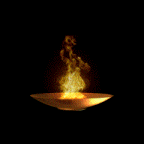 |
||||||||||||||||||||||
|
